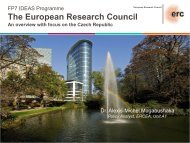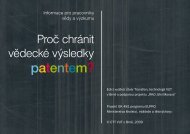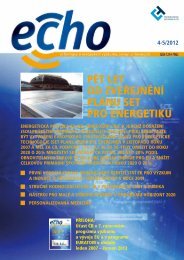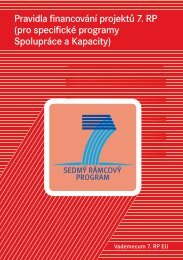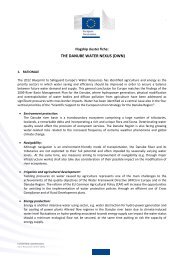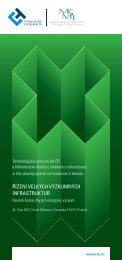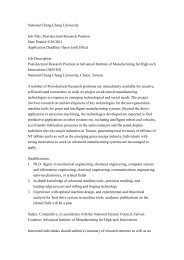Explanatory Note - FFG 7. Rahmenprogramm
Explanatory Note - FFG 7. Rahmenprogramm
Explanatory Note - FFG 7. Rahmenprogramm
Create successful ePaper yourself
Turn your PDF publications into a flip-book with our unique Google optimized e-Paper software.
1. Acceptability criteria for average personnel cost<br />
The new criteria adopted established in Article II.14.1 of the ECGA as modified by the<br />
Commission on 24/1/2011, provide for the acceptance of the vast majority of average<br />
personnel cost methods used by beneficiaries as their usual cost accounting practice. Those<br />
criteria are as follows:<br />
a. The average personnel cost methodology shall be the one declared by the beneficiary<br />
as its usual cost accounting practice; as such it shall be consistently applied to all<br />
indirect actions of the beneficiary under the Framework Programmes;<br />
b. The methodology shall be based on the actual personnel costs of the beneficiary as<br />
registered in its statutory accounts, without estimated or budgeted elements;<br />
c. The methodology shall exclude from the average personnel rates any ineligible cost<br />
item and any costs claimed under other costs categories in order to avoid double<br />
funding of the same costs;<br />
d. The number of productive hours used to calculate the average hourly rates shall<br />
correspond to the usual management practice of the beneficiary provided that it<br />
reflects the actual working standards of the beneficiary, in compliance with applicable<br />
national legislation, collective labour agreements and contracts and that it is based on<br />
auditable data.<br />
These criteria will apply without prejudice to the other general eligibility criteria set out in<br />
FP7 Rules for Participation and the ECGA (i.e. cost should be incurred during the duration of<br />
the project, indicated in the overall budget, etc). Personnel costs declared to FP7 projects<br />
resulting from the application of calculation methods fulfilling the above mentioned criteria<br />
are deemed not to differ significantly from the actual costs.<br />
Beneficiaries are no longer required to submit a Certificate on Average Personnel Costs<br />
(CoMAv) for approval as a prior condition for the eligibility of the costs. Nevertheless, the<br />
CoMAv remains as an option offering beneficiaries the possibility to obtain prior assurance<br />
on the compatibility of the methodology in place with FP<strong>7.</strong> All beneficiaries applying average<br />
personnel costs are entitled to submit a CoMAV. Methodologies submitted for approval will<br />
be assessed against the criteria defined above. Procedures for the submission and treatment of<br />
the CoMAv remain unchanged and can be consulted at the FP7 Guidance <strong>Note</strong>s for<br />
Beneficiaries and Auditors 1 . Where needed, the Commission will modify the Form D and<br />
Form E in order to adapt the templates to the new criteria. Further guidance on certification<br />
can be found in the above mentioned Guidance <strong>Note</strong>s for Beneficiaries and Auditors.<br />
Particular aspects of the acceptability criteria<br />
Criterion a: Usual cost accounting practice declared by the beneficiary<br />
1<br />
ftp://ftp.cordis.europa.eu/pub/fp7/docs/guidelines-audit-certification_en.pdf
The methodology applied should be the usual cost accounting practice of the beneficiary . The<br />
terms "..shall be the one declared by the beneficiary" means that the Commission will<br />
consider that by submitting and signing financial statements (Form C) calculated by means of<br />
a given methodology, the beneficiary is declaring that such methodology is its usual costs<br />
accounting practice. Where necessary this usual cost accounting practice should be adjusted in<br />
order to fulfil all the acceptability criteria. For instance, this would be the case when the usual<br />
personnel cost calculation method includes ineligible items which would need to be removed<br />
(e.g. indirect taxes).<br />
This criterion does not require the average personnel costs methodology to be equal for all<br />
types of employees, departments or cost centres. If, for instance, the usual cost accounting<br />
practice includes different calculation methods for permanent personnel and temporary<br />
personnel, this is acceptable. However, the overall methodology must be consistently applied<br />
in all FP7 participations of the beneficiary and can not be adapted ad-hoc for particular<br />
research actions or specific projects.<br />
Criterion b: Based on the statutory accounts<br />
In order to guarantee that the average cost rates used in the methodology are based on actual<br />
costs, the calculation method should compute personnel cost rates resulting from the payroll<br />
figures registered in the statutory accounts of the entity.<br />
Budgeted or estimated figures are not costs actually incurred and, as such, can not be accepted<br />
as eligible components of the personnel costs. Notwithstanding this, when the actual amount<br />
of some element of the personnel costs is not known at the time of the preparation of the<br />
financial statements (Form C), beneficiaries are entitled to use the last available financial data<br />
or the best possible estimation of the actual costs. In those cases, the costs claimed must be<br />
adjusted according to the actual costs incurred as registered in the beneficiary's accounts in<br />
the subsequent period or, at the latest, at the time of the submission to the Commission of the<br />
final report of the project. The resulting adjustment to the costs already charged should be<br />
declared in an additional Form C indicating that it is an adjustment to a previous statement<br />
(by ticking out the yes option in the specific box).<br />
Criterion c: Excluding ineligible costs and double funding<br />
Cost declared to be ineligible by the Commission, in particular those enumerated in Article<br />
II.14.3 of Annex II to ECGA, need to be removed from the personnel rates. If the usual<br />
accounting practice includes any element considered ineligible, the personnel rates would<br />
need to be adjusted by withdrawing such components from the pool of personnel cost. In case<br />
of doubts regarding the eligibility of an item, the question can be raised to the Commission<br />
via the network of National Contact Points 2 or the Research Enquiry Service 3 .<br />
The methodology should also prevent double funding of the same costs. As an example,<br />
certain methodologies include in the calculation of the personnel rates cost components which<br />
are part of the indirect costs in the beneficiaries' accounts. In such situations, if the beneficiary<br />
uses real indirect costs, the methodology should ensure that those items are removed from the<br />
pool of costs used to calculate the indirect cost charged to the FP7 projects. In the particular<br />
2<br />
3<br />
http://cordis.europa.eu/fp7/ncp_en.html<br />
http://ec.europa.eu/research/index.cfmpg=enquiries
case of beneficiaries applying a flat-rate indirect cost method, the personnel cost cannot<br />
include any indirect cost element as these are covered by the flat-rate.<br />
Criterion d: Productive time<br />
As a general rule, the number of productive hours should be that applied as the usual practice<br />
of the beneficiary. For instance, beneficiaries could use the actual productive hours of each<br />
researcher according to the time-records or instead use a standard number of productive hours<br />
(generally annual productive hours). When the beneficiary applies a standard number of<br />
productive hours, this should be representative of its working standards. Background<br />
information used to determine the standard productive hours should be available and<br />
verifiable.<br />
An illustrative example could be a case where a beneficiary deducts 7 working days a year as<br />
average illness absence of the employees when calculating the annual productive hours. The<br />
records substantiating this figure should be available in case of an audit. Besides, if the<br />
records on illness absences show that systematically the number of days is lower than 7, this<br />
could be a reason for the Commission to re-evaluate the appropriateness of the standard<br />
number of annual productive hours.<br />
Please note that the Commission does not consider billable hours (hours that can be directly<br />
charged to customer/grantors) as equivalent to productive time. Billable hours are commonly<br />
much lower than productive hours, resulting in an overstatement of the personnel costs.<br />
For more information on the concept of productive hours please refer to the section for Article<br />
II.15.1 (a3) of this Guide.<br />
Retro-active application<br />
These new criteria are applicable to costs declared in all FP7 projects. Beneficiaries can<br />
therefore directly apply their usual average personnel costs calculation method, if compatible<br />
with these criteria, for any cost declaration. However, the beneficiary is not allowed to<br />
recalculate costs which were already reported by application of other calculation methods due<br />
to the fact that the usual methodology is now acceptable under the criteria described above.<br />
For instance, if the beneficiary has charged individual actual costs due to the fact that its<br />
average personnel cost methodology was not acceptable by the Commission under the prior<br />
criteria, the beneficiary can not re-calculate at present those costs by using averages, even if<br />
its methodology is now acceptable.<br />
The Commission will also apply these new criteria in all ongoing and future FP7 audits.
Certificates on the methodology for average personnel costs<br />
The ex-ante 4 certificates on the methodology are a measure aimed to prevent interpretational<br />
errors of the FP7 rules. Apart from the clerical mistakes, most errors found during<br />
Commission's audits are the result of incompatibilities between certain costs accounting<br />
practices and the financial provisions, or due to an incorrect reading of rules. The Certificates<br />
on the methodology allow beneficiaries to submit a description of the calculation methods<br />
applied for the FP7 projects and obtain from the Commission the assurance that the<br />
methodology, as described in the certificate, is in line with the rules of the framework<br />
programme. In order to simplify the administrative requirements for beneficiaries, the<br />
Commission has opted not to continue requiring the submission of the CoMAv for<br />
beneficiaries applying average personnel costs. However, in view of the evident preventive<br />
value of this certificate, it remains as a voluntary option for these beneficiaries.<br />
During the period of application of the interim acceptability criteria adopted in June 2009, a<br />
certain number of beneficiaries have implemented adjustments in their usual methodology in<br />
order to obtain its approval by the Commission. All methodologies approved under the former<br />
criteria fulfil, by definition, the new criteria. Thus, those beneficiaries who have obtained the<br />
approval of their average personnel costs methodology prior to this decision (under the former<br />
criteria) are entitled either to:<br />
• Continue applying the approved methodology;<br />
• Or to revert to their usual accounting practice, if different from the approved<br />
methodology, in so far as this fulfils the new acceptability criteria.<br />
Beneficiaries opting to revert to their usual accounting practice are entitled to submit for<br />
approval a new Certificate on the methodology. It is recommended that beneficiaries in this<br />
situation inform the Commission on their choice via the functional mailbox:<br />
RTD-FP7-Average-Personnel-Rate-Certification@ec.europa.eu<br />
Commission audits<br />
In case of an audit, the Commission auditors will verify that the average personnel costs<br />
calculation method fulfils the acceptability criteria. If a Certificate on the Methodology<br />
(CoM) covering average personnel costs or a Certificate on Average Personnel Costs<br />
(CoMAv) has been approved for the beneficiary, this will be duly taken into account by the<br />
auditor. If the average personnel costs methodology is compliant with the acceptability<br />
criteria, the audit will verify the correct implementation of the methodology, the respect of<br />
other general eligibility criteria and the accurate calculation of the costs (i.e. free of clerical<br />
mistakes).<br />
In case that the methodology fails to respect one or several criteria, the auditor will correct,<br />
when possible, the average rates applied by the beneficiary and propose the corresponding<br />
financial adjustments on such basis. This can occur, for instance, if the auditor notices<br />
4<br />
In this context, ex-ante means prior to the declaration of the costs
ineligible costs included in the calculation of the personnel rates and the precise amount can<br />
be identified and removed in order to re-calculate the rates. The Commission auditor will not<br />
calculate the individual actual costs of the researchers participating in the EU projects except<br />
in exceptional cases. These exceptional cases could be, among others:<br />
• When the average personnel cost methodology is not the usual cost accounting<br />
practice of the beneficiary for FP7 projects.<br />
• When the methodology is not based on the actual payroll costs registered in the<br />
statutory accounts of the entity.<br />
• For cases of ineligible items, double charging of costs or use of estimated or budgeted<br />
elements: when the beneficiary does not grant access to the necessary information and<br />
supporting documents allowing to re-calculate the average personnel rates.<br />
Finally, costs reported prior to the adoption of this decision will be audited following the<br />
calculation method applied by the beneficiary at the time of the cost declaration. In particular:<br />
• For cost statements where the beneficiary had declared individual personnel costs, the<br />
auditor will verify the calculations on such basis even if the beneficiary applies at<br />
present average personnel costs.<br />
• For costs statements submitted by application of average personnel costs, the auditor<br />
will apply the current acceptability criteria.<br />
2. Flat-rate financing for SME 5 owners and natural persons: The<br />
case of physical persons and SME owners who do not receive a<br />
salary<br />
New situation: Following a Commission decision of 21/01/2011, Article II.14.1 of Annex II<br />
of the ECGA has been modified in order to allow SME owners who do not receive a salary<br />
and other natural persons who do not receive a salary, to charge as personnel costs a flat rate<br />
based on the allowances used in the People Specific Programme ("Marie Curie" flat-rates).<br />
Target group: SME owners and other natural persons who do not receive a salary, including<br />
those who are remunerated/compensated by whichever other means such as dividends, service<br />
contracts between the company and the owner, etc.<br />
"A contrario", employees of the SME and other natural persons who do receive a salary<br />
registered as such in its accounts can not use this flat rate.<br />
5<br />
SME: Small and Medium Enterprises
It might, however, be possible to use this flat-rate for the cases where the SME owner can<br />
show evidence that his/her salary corresponded exclusively to the management of the SME,<br />
not to his/her research work.<br />
Procedure: During the negotiation of the ECGA the beneficiaries concerned will present an<br />
estimation of their expected personnel costs for the project on the basis of the formula<br />
described below. The amount of this flat-rate will appear in the table included in Annex I to<br />
the Grant Agreement, as indicated in article 5.2.<br />
The Commission may verify, at the time of the negotiation of the grant and/or during the<br />
implementation or audit of the project, that the beneficiary fulfils the conditions to charge this<br />
flat-rate, as well as the correct application of the formula.<br />
When submitting personnel costs in the Form C, beneficiaries will calculate those by applying<br />
the hourly rate resulting from the formula to the actual hours worked in the project. The total<br />
number of hours claimed for the EU projects in a year cannot be higher than the standard<br />
number of productive hours per SME owner/physical person (i.e.:1575). The resulting figure<br />
should appear in the form C under the cost category: "lump-sum/flat-rate/scale of unit<br />
declared".<br />
Retroactive application: This form of flat-rate financing shall apply to all grant agreements<br />
signed under the Seventh Framework Programmes, including those already signed.<br />
Calculation of the flat rate: The formula indicated in the new Article II.14.1 of the ECGA<br />
will apply:<br />
a) "SME owners who do not receive a salary and other natural persons who do not receive a<br />
salary shall charge as personnel costs a flat rate based on the ones used in the People<br />
Specific Programme for researchers with full social security coverage, adopted by Council<br />
Decision No 2006/973/EC 6a , and specified in the annual Work Programme of the year of the<br />
publication of the call to which the proposal has been submitted 6b ".<br />
The value of the personal work of those SME owners and natural persons shall be based on a<br />
flat rate to be determined by multiplying the hours worked in the project by the hourly rate to<br />
be calculated as follows:<br />
{Annual living allowance corresponding to the appropriate research category published in<br />
the 'People' Work Programme of the year of the publication of the call to which the proposal<br />
has been submitted / standard number of annual productive hours} multiplied by {country<br />
correction coefficient published in the 'People' Work programme of the year of the<br />
publication of the call /100}<br />
FP7 'People' Work Programmes can be obtained at the following address:<br />
http://cordis.europa.eu/fp7/find-doc_en.html<br />
6a<br />
6b<br />
OJ L 400, 30.12.2006, p.272.<br />
For calls published in 2006 the flat rates to be applied are those of the People Work Programme 2007
For years 2007-2008-2009 these annual living allowances are published in Annex 3 to the<br />
relevant work programme, under the column A (not B) of the table called: (yearly) reference<br />
rates for monthly living allowances. For the years 2010 and after the same applies, with the<br />
particularity that there is a single column (no longer A or B) to be used as reference.<br />
The different amount to be applied depends on the appropriate researcher category, which<br />
shall be defined by considering the years of professional experience of the SME<br />
owner/natural person. The reference date for the calculation of the numbers of years of<br />
experience to be taken into account is the relevant deadline for submission of proposals.<br />
The country correction coefficients are published in the table called "correction coefficients"<br />
which appears afterwards in the same document.<br />
In any case the number of hours actually worked for the project should be duly justified by<br />
supporting time-records in the same way as for any other type of beneficiary. Further<br />
information can be found in the dedicated section in this Guide.<br />
The Commission will implement in the Participant Portal an on-line tool assisting<br />
beneficiaries to calculate the applicable rate for each individual case.<br />
b) The standard number of productive hours is equal to 1 575. The total number of hours<br />
claimed for European Union projects in a year cannot be higher than this standard number of<br />
productive hours per SME owner/natural person.<br />
This means that, independently from the real number of productive hours of the person<br />
concerned, the only figure to be used for this concept (productive hours) is set at 1 575 hours.<br />
This applies only for the calculation of this formula for this special case of SME<br />
owners/natural persons not receiving a salary. In the other cases (declaration of personnel<br />
costs on the basis of actual/average costs) the usual rules for productive hours detailed before<br />
in this Guide apply.<br />
Furthermore, and also for this special case of SME owners/natural persons not receiving a<br />
salary, the maximum number of hours claimed by the same SME owner/natural person when<br />
adding all the hours worked for EU projects in the same year can not be superior to 1 575.<br />
c) The value of the personal work shall be considered as a direct eligible cost of the project"<br />
This statement means that the flat-rate covers only the direct personnel costs. Therefore, the<br />
indirect costs flat rates may be applied on top to cover the indirect costs.<br />
Reimbursement: The FP7 upper funding limits according to the type of beneficiary, funding<br />
scheme and activity detailed in Article II.16 of the ECGA apply in order to determine the<br />
European Union financial contribution.<br />
Example: SME owner without salary from Austria, fulfilling the conditions set in Article<br />
II.15.2 of the ECGA to apply the 60% flat indirect cost rate for funding schemes with research<br />
activities, with:<br />
• 4 year of experience at the time of the deadline for the submission of the proposals,
• Beneficiary in one Cooperative Project (A) and one CSA project (B) selected in calls<br />
published in 2009.<br />
• In 2011 this SME owner has worked 800 hours for project A and 800 for project B.<br />
• He has also incurred EUR 3,000 in other direct costs for research activities (e.g. travel<br />
/accommodation costs) for project A, and equally EUR 4,000 for project B.<br />
In 2010, at the time of the negotiation of the Grant, the beneficiary will calculate the<br />
estimated value of the personal work for the project using the formula detailed above. He<br />
(through the coordinator) will indicate this amount in the table foreseen for lump-sums/flat<br />
rates to be included in the Annex I to the GA.<br />
At the end of the first reporting period (e.g. January 2011 - December 2011) he will apply the<br />
formula to the number of actual hours worked for EU projects that year. For this, he/she will<br />
take as reference the relevant figure published in the "People" Work Programme in 2009 for a<br />
researcher with 4 years of experience: 54,300 EUR/year<br />
Project A (Collaborative Project): 800 hours:<br />
54.300 / 1575 = 34,476 multiplied by 102,2 (correction coefficient for Austria) and divided by<br />
100 = 35,234 EUR/hour<br />
Personnel work for Project A in 2011 of this SME owner without salary:<br />
750 hours worked in RTD activities multiplied by EUR 35,234 = EUR 26.425,5<br />
50 hours worked in Management activities multiplied by EUR 35,234 = EUR 1.761,7<br />
Total direct costs in RTD activities for Project A= EUR 26.425,5 + 3000 = EUR 29.425,5<br />
Total indirect costs in RTD activities for Project A = EUR 29.425,5 X 60% = EUR 1<strong>7.</strong>655<br />
Total costs in RTD activities: EUR 4<strong>7.</strong>080,5<br />
EU funding = EUR 4<strong>7.</strong>080,5 X 75% (funding rate for RTD activities for SMEs) = EUR<br />
35.310,38<br />
Total direct costs in Management activities for Project A = EUR 1.761,7<br />
Total indirect costs in Management activities= EUR 1.761,7 X 60% = EUR1.057<br />
Total costs in Management activities= EUR 2.818,7<br />
EU funding = EUR 2.818,7 X 100% (funding rate for Management activities) = EUR 2.818,7<br />
TOTAL EU funding in Project A for 2011 = EUR 38.129,1<br />
Project B: Cooperation and Support Action (CSA): 800 hours worked in 2011<br />
First of all, if this SME owner has already charged 800 working hours to Project A, it can<br />
only charge now in the same year 775 hours to project B to secure consistency with the<br />
standard number of productive hours equating to 1575.
The formula applied is the same as for project A, as the Work Programme to use is also that<br />
of 2009:<br />
EUR 54.300 / 1575 = EUR 34.476 multiplied by 102.2 (correction coefficient for Austria) and<br />
divided by 100 = 35,234 EUR/hour<br />
However the calculation of costs and EU funding is different as the funding scheme here is a<br />
CSA, which has got no RTD activities:<br />
Total direct costs for 725 hours worked in "other activities" = 725 X EUR 35,234 = EUR<br />
25.544,65<br />
Total direct costs for 25 hours worked in "management activities" = 25 X EUR 35,234 = EUR<br />
880,85<br />
Total direct costs = EUR 26.425,5 + 4.000 = EUR 30.425,5<br />
EU funding for direct costs (as direct costs of both "other" and" management" activities are<br />
reimbursed at 100%) = EUR 30.425, 5<br />
EU funding (reimbursement) for indirect costs in a CSA project = max 7% of Direct costs<br />
(excluding subcontracting and costs of resources made available by third parties and not used<br />
in the premises of the beneficiary) = 7% of EUR 30.425.5 = EUR 2.129,79<br />
TOTAL EU funding in project B for 2011= 30.425,5 + 2.129,79 = EUR 32.555,29<br />
Audit: as this is a flat rate, in case of audit the elements to be verified will be limited to those<br />
which are part of the formula (use of the appropriate living allowance, experience of the SME<br />
owner/natural person, country coefficient, etc) as well as the justification of the hours charged<br />
to the project and the respect of the 1575 hours-limit per year.<br />
In case an audit finds out that an SME owner/natural person has unduly charged personnel<br />
costs on the basis of actual costs without receiving a salary, those costs will be rejected and<br />
the flat-rate system will automatically apply instead. For overstated amounts, Article II.24 of<br />
the ECGA applies, and the beneficiary shall be liable to pay liquidated damages on any<br />
amount charged over the value provided by the flat-rate system calculation<br />
This flat-rate system will apply to all on-going and future audits in FP<strong>7.</strong> The Commission will<br />
review the testing methods to be applied during audits and will where necessary update the<br />
Guidance <strong>Note</strong>s made available for beneficiaries and auditors.<br />
Submission of Certificates:<br />
The submission of a Certificate on Average personnel costs is no longer possible for the cases<br />
of SME owners and natural persons without a salary. Certificates submitted up to the date of<br />
the decision, or at the latest one month after such date will be treated and evaluated under the<br />
rules in force prior to the decision. Certificates submitted later than one month of the date of<br />
adoption will be considered not receivable.<br />
All SME owners and natural persons having received the approval of their methodology are<br />
entitled either to:<br />
• Continue applying the approved methodology
• Apply the flat rate system<br />
However, if the beneficiary chooses to apply the flat-rate system they will have to apply it for<br />
all cost statements in ongoing and future participations in FP7 projects. It is recommended<br />
that beneficiaries in this situation inform the Commission on their choice via the functional<br />
mailbox:<br />
RTD-FP7-Average-Personnel-Rate-Certification@ec.europa.eu<br />
Where necessary, the CFS (Form D) will be adapted as regards the value of the personnel<br />
work in the project being funded through flat-rate financing. The Commission will review the<br />
testing methods to be applied during audits and will update the Guidance <strong>Note</strong>s made<br />
available for beneficiaries and auditors.<br />
As regards ongoing projects, personnel costs submitted prior to the modification of Article<br />
II.14.1 of the ECGA by SME owners and natural persons without a salary not having a<br />
certificate approved by the Commission will be considered eligible up to the limit of the<br />
applicable flat rate. For future cost statement, these beneficiaries will apply the corresponding<br />
flat rate and declare, where necessary, adjustments to the costs previously reported (i.e. in the<br />
case that the costs charged in previous periods are different than those resulting from the<br />
application of the flat rate).



